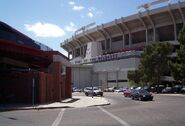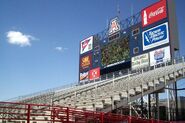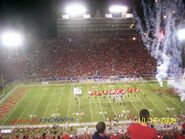(Created page with "{{Infobox Stadium | stadium_name = Arizona Stadium | nickname = | image = 250px | location = 530 North Vine Avenu...") |
(Adding categories) |
||
| Line 50: | Line 50: | ||
* [http://www.arizonawildcats.com/facilities/ariz-stadium.html Arizona Athletics.com] - official athletics site - Arizona Stadium |
* [http://www.arizonawildcats.com/facilities/ariz-stadium.html Arizona Athletics.com] - official athletics site - Arizona Stadium |
||
* [http://msrmaps.com/image.aspx?T=4&S=11&Z=12&X=1261&Y=8914&W=3&qs=%7cTucson%7cAZ%7c Aerial photo & topographic map - UA campus] from USGS via Microsoft Research Maps |
* [http://msrmaps.com/image.aspx?T=4&S=11&Z=12&X=1261&Y=8914&W=3&qs=%7cTucson%7cAZ%7c Aerial photo & topographic map - UA campus] from USGS via Microsoft Research Maps |
||
| + | [[Category:Stadiums]] |
||
Revision as of 03:02, 1 December 2011
| Arizona Stadium | |
|---|---|
| File:ArizonaStadium1.jpg | |
| Location | 530 North Vine Avenue Tucson, AZ 85721 |
| Coordinates | Lua error in Module:Coordinates at line 489: attempt to index field 'wikibase' (a nil value). Fatal error: The format of the coordinate could not be determined. Parsing failed. |
| Broke ground | December 1927 |
| Opened | October 13, 1928[1] |
| Expanded | 1938, 1947, 1950, 1965, 1976, 1988, 1990 |
| Owner | University of Arizona |
| Operator | University of Arizona |
| Surface | Bermuda grass |
| Construction cost | $166,888[2] ($NaN in 2024 dollars[3]) |
| Architect | Roy Place[4] |
| Project Manager | J. F. Garfield[5] |
| General Contractor | Orndorff Construction Co.[6] |
| Tenants | Arizona Wildcats (NCAA) (1929–present) Insight Bowl (NCAA) (1989–1999) |
| Capacity | 57,400 (2007-present) 56,000 (2000-2006) 57,803 (1990-1999) 54,071 (1988-1989) 49,671 (1976-1987) 32,671 (1965-1975) 22,671 (1950-1964) 14,000 (1947-1949) 10,000 (1938-1946) 7,000 (1928-1937) |
Arizona Stadium is an outdoor football stadium on the campus of the University of Arizona in Tucson, Arizona, United States. It is the home field of the Arizona Wildcats of the Pacific-12 Conference, and its current seating capacity is 57,803.
Located in central Tucson, the stadium has been home to Wildcat football since 1928. Initially, stadium capacity was just 7,000, with seating located on the stadium's west side. Arizona's first game at the facility was October 12, 1929 when the Wildcats defeated Caltech 35-0. Capacity was raised to 10,000 in 1938 when seats were constructed on the east side of the stadium. Additional seating was added to both end zones in 1947. This added an additional 4,000 seats.
In 1950, a horseshoe configuration was constructed around the south end zone resulting in the addition of almost 8,700 seats. A multi-level press box and 10,000 seats were added to the west grandstand in 1965. The east side of the stadium received a second tier, consisting of 17,000 seats, in 1976, as the Wildcats prepared to leave the WAC for the Pac-8 in 1978.
In 1981, the track team moved out and the track was removed. Permanent seating was placed at the north end of the end zone in 1988. Following the 1988 season, a new press box with luxury sky boxes replaced the aging structure built more than two decades earlier. Prior to the 1999 season, a new state-of-the-art scoreboard was installed complete with video monitor.
The football field runs in the traditional north-south configuration and the natural grass playing field sits at an elevation of 2430 feet (740 m) above sea level.[7]
In addition to hosting football games, the stadium also includes two dormitories, Pinal and Navajo, in the South stands, and Sierra Hall, which today is home to offices for the music department and Residence Life, located under the east stands. The Steward Observatory Mirror Lab, a mirror fabrication facility for large telescopes, sits under the east wing of Arizona Stadium.[8]
In September 2009, UA announced a long-term $378 million sports expansion project that would include an expansion of the north end zone stands. The expansion would include a four-story building that would house locker rooms and football offices, among other things.[9] In January 2011, it was announced that a new Template:Convert/LoffAoffDbSon video board would be installed above the south stands in time for the 2011 season. It will be the third-largest video screen in college football.[10]
References
- ↑ http://www.fanbase.com/Arizona-Wildcats-Football-1928
- ↑ http://parentseyes.arizona.edu/placesinthesun/stadium.php
- ↑ Consumer Price Index (estimate) 1800–2008. Federal Reserve Bank of Minneapolis. Retrieved December 7, 2010.
- ↑ http://parentseyes.arizona.edu/placesinthesun/stadium.php
- ↑ http://parentseyes.arizona.edu/placesinthesun/stadium.php
- ↑ http://parentseyes.arizona.edu/placesinthesun/stadium.php
- ↑ USGS topographic map
- ↑ Steward Observatory Mirror Lab
- ↑ UA's $378M sports upgrade. Arizona Daily Star (2 September 2009). Retrieved on 2 September 2009.
- ↑ Byrne: North end zone project full-speed ahead. Arizona Daily Star (11 January 2011). Retrieved on 12 January 2011.
External links
- Arizona Athletics.com - official athletics site - Arizona Stadium
- Aerial photo & topographic map - UA campus from USGS via Microsoft Research Maps



